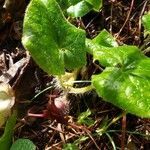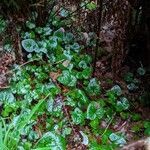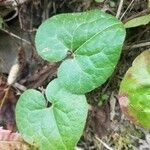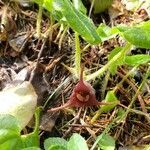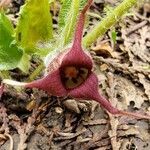Rhizomes horizontal, shallow, internodes (0.5-)1.5-6.5 cm. Leaves: petiole 7.5-17 cm, sparsely crisped-hirsute. Leaf blade not variegate, cordate, 3-8.5 × 4.5-12 cm, apex usually obtuse, occasionally broadly acute; surfaces abaxially sparsely appressed-hirsute, at least proximally, adaxially glabrous or sparsely appressed-hirsute, marginal hairs perpendicular to margin or curved toward apex. Flowers horizontal; peduncle 1.5-5 cm; false calyx tube cylindric, externally brown-purple, rarely greenish, hirsute, internally white, usually with median purple stripe, with usually purple, rarely white hairs; distal portion of sepal spreading or weakly (rarely strongly) reflexed at anthesis, (11-)30-75 mm, apex filiform-attenuate, abaxially purple or greenish, sparsely hirsute, adaxially purple, puberulent with crisped purple hairs; pollen sacs 1.5-2 mm, sterile tip of connective on inner stamens purple, 0.5-1 mm, shorter than pollen sacs. 2 n = 26.
More
A herb with thick creeping rootstocks which produce new shoots. It grows 8-10 cm high and spreads 80-100 cm wide. Each shoot has 2 leaves and a flower. The leaves are heart shaped. The flowers are often hidden below the flowers. The flower is purplish-brown. It has 3 lobes drawn out into 5 cm long tails.
It is a warm temperate plant. It is native to the west coast of North America. It grows in moist shaded woods. It grows up to 1520 m altitude. It is best in humus-rich, moist soils. It is frost resistant but drought tender. It suits hardiness zones 7-9.
More
Deep shade in moist pine woods and redwood forests. Understory of conifer forests, usually in mesic or wet places; at elevations from sea level to 1,200 metres and occasionally to 2,200 metres.
